Fall Foray to Crane Hollow
September 28-30, 2018
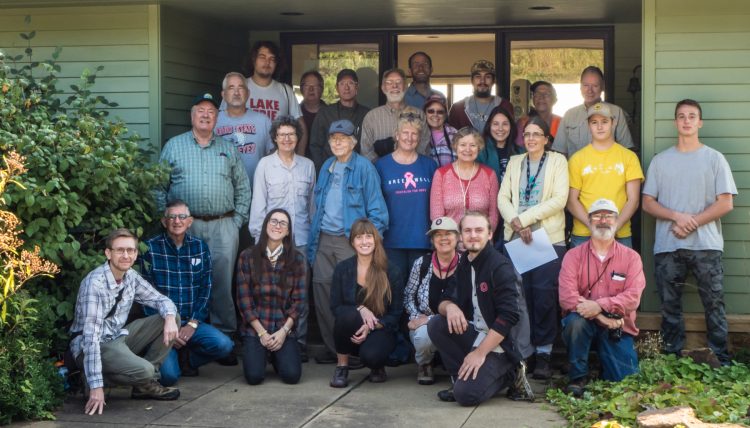
Hocking County Fall 2018
History. In terms of cryptogams, Hocking County is the best collected county in Ohio. Of the approximately 420 Ohio moss species, 244 have been collected in Hocking County. One of the most diverse areas in Hocking County is the Crane Hollow Preserve. Snider and Se (1990) performed a thorough survey of bryophytes in Crane Hollow. They found 179 mosses, 45 liverworts, and 3 hornworts. During further exploration of Crane Hollow Preserve, Barb Andreas and Joe Moosbrugger found Neckera pennata (Andreas & Lucas 2017), and Loeskeobryum brevirostre.
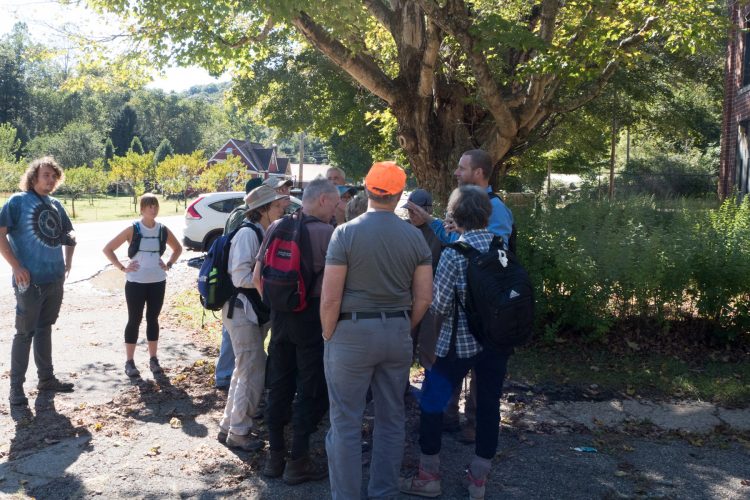
Getting the lay of the land on Friday afternoon.
Hocking County is rich in macrolichens. Of the approximate 225 species in Ohio, about 120 were reported from Hocking County. Ray Showman (1987) published a list of the macrolichens from Crane Hollow Preserve. He reported 77 species. In a follow-up survey, he reported five more species (Showman 1993).
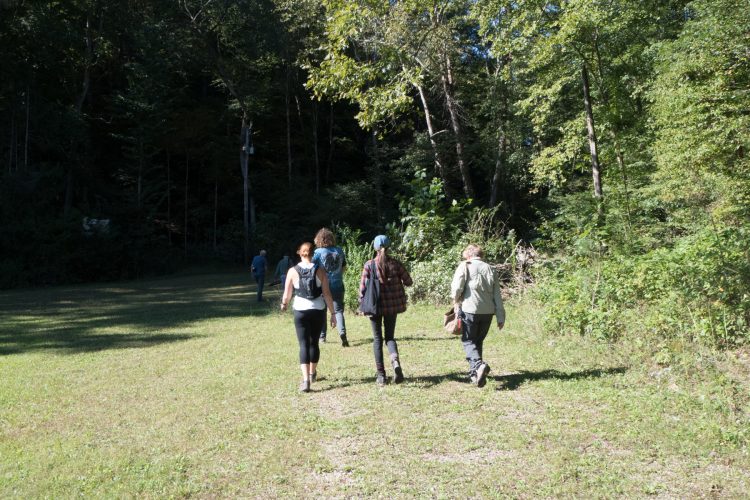
Friday afternoon visit to a non-contiguous and non-dedicated parcel
located to the east of the town of South Bloomingville.
Crane Hollow Preserve is named for the large hollow running from north to south throughout the preserve. The northern third of this valley is comprised of two near-equal sized drainages that form a “Y,” with Crane Hollow to the west and Hood Hollow to the east.
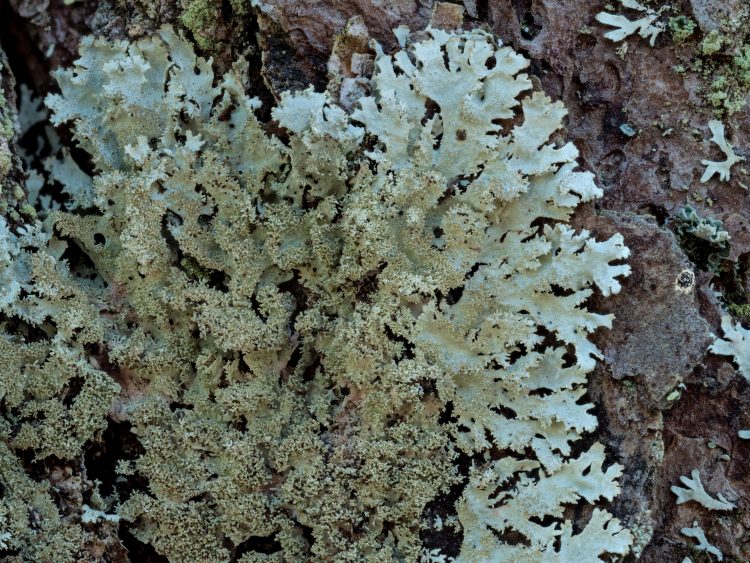
Imshaugia aleurites is an isidiate foliose lichen found on conifer bark.
William and Jane Ann Ellis founded Crane Hollow in 1977 with the purchase of 434 acres within the Crane Hollow watershed. In 1978, they purchased an additional 55 acres, and these properties formed the nucleus of Crane Hollow Preserve.
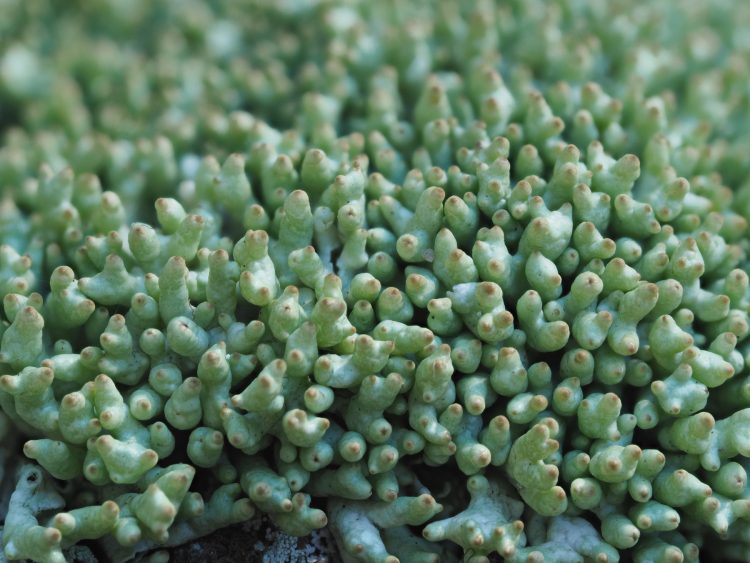
Pycnothelia papillaria is a distinctive fruticose lichen.
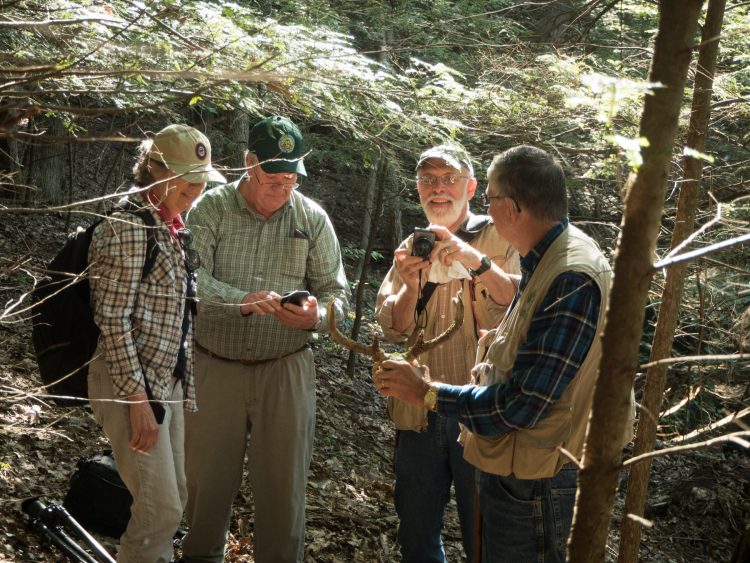
Ray, Ian, Kathy and Bob examine a lichen.
In the 1980s and 1990s, additional parcels were purchased. A partnership was formed between the Ohio Department of Natural Resources’ (ODNR) Division of Natural Areas and Preserves (DNAP) and Crane Hollow Preserve, allowing for the dedication of part of Crane Hollow to be the 96th dedicated state nature preserve. Crane Hollow Preserve is composed of both dedicated and non-dedicated parcels. As of September 2018, 1,285 acres are dedicated, with an additional 702 acres being non-dedicated, but still managed by Crane Hollow Preserve. In all, Crane Hollow Preserve is composed of 1,987 acres.
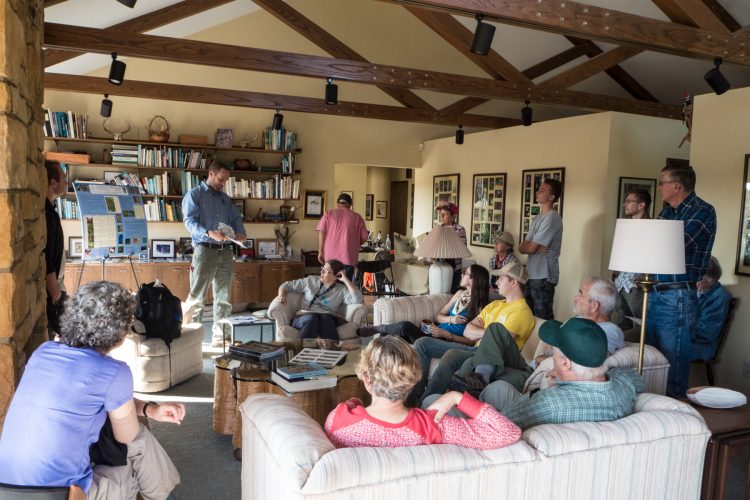
Joe orients the group before heading out to the field.
The purpose of selecting Crane Hollow Preserve for the fall foray was to visit land acquisitions added to the Preserve after the first surveys by Snider, Se and Showman. Crane Hollow also provided an opportunity for OMLA members to see a high diversity of species.
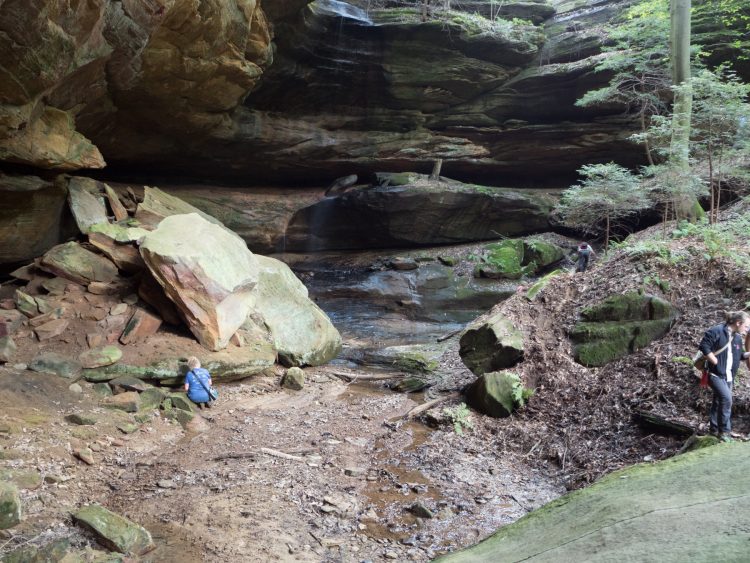
Early Hollow.
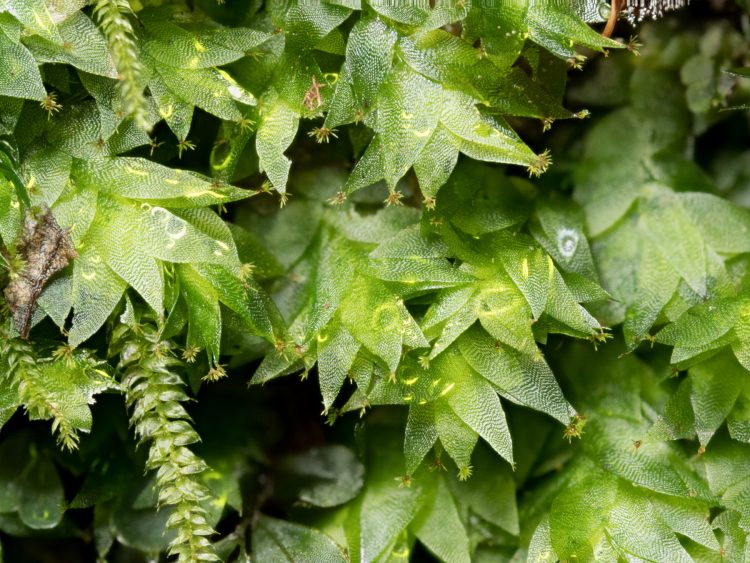
Hookeria acutifolia inhabits recesses in cliffs.
Note the gemmae at the leaf tips.
2018 Fall Foray Results. On Friday, 28 September 2018, OMLA visited a non-contiguous and non-dedicated parcel located to the east of the town of South Bloomingville. On Saturday, 29 September 2018, OMLA visited two non-contiguous and non-dedicated parcels, Early Hollow and Goldmine Hollow, located to the east of St. Rt. 374, near Gibisonville. On Sunday, 30 September 2018, OMLA surveyed the south-facing rim of Young Hollow, part of the contiguous and dedicated Crane Hollow holdings. Species lists are shown at the bottom of this page.
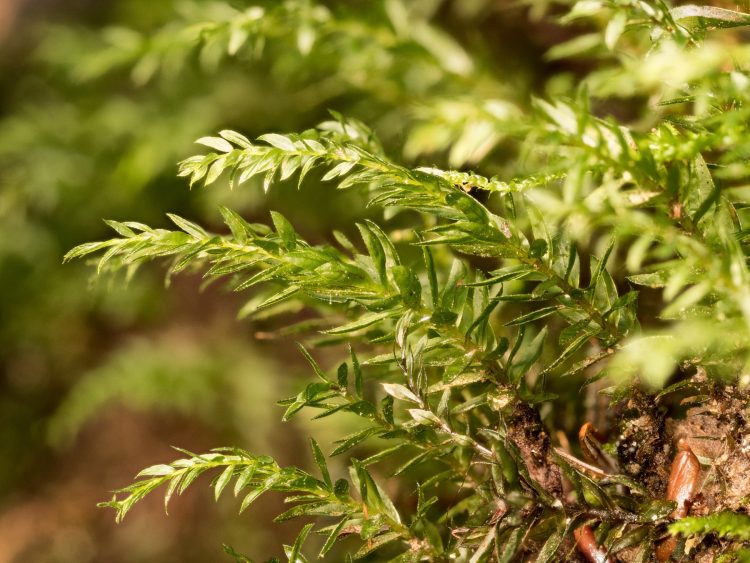
Mnium hornum is an infrequently encountered acrocarp moss with arching stems and double-toothed leaves.
BRYOPHYTE RESULTS. Results of the bryophytes found during the 2018 fall foray are presented in the table below. Ninety six moss species, 33 liverwort species, and one hornwort species were collected from the study areas. Diane Lucas found Orthotrichum ohioense near the Crane Hollow Preserve office.
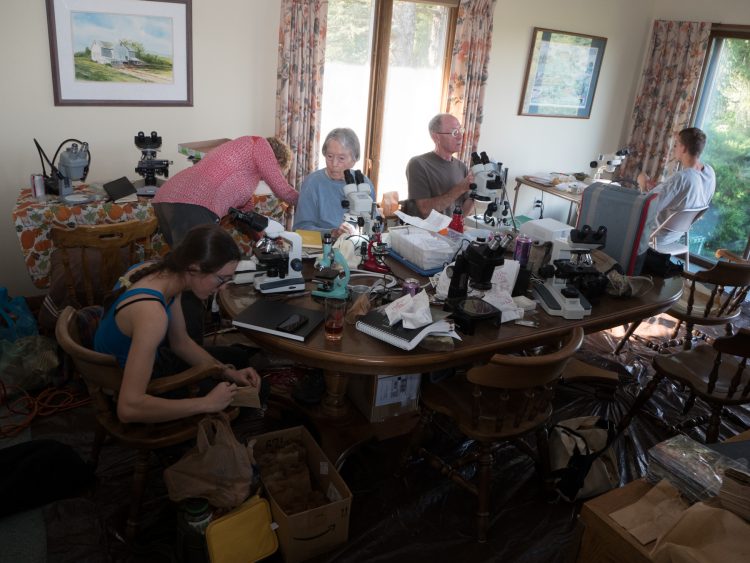
The Saturday night “scope room” is a field laboratory.
Three species are new to Hocking County: Bryoerythrophyllum recurvirostrum (Pottiaceae), collected by Carole and Bill Schumacher; Didymodon ferrugineus (Pottiaceae), collected by Megan Osika; and Orthotrichum speciosum (Orthotrichaceae), collected by Barb Andreas. Eleven moss species and nine liverwort species are reported as new for the Crane Hollow Preserve.
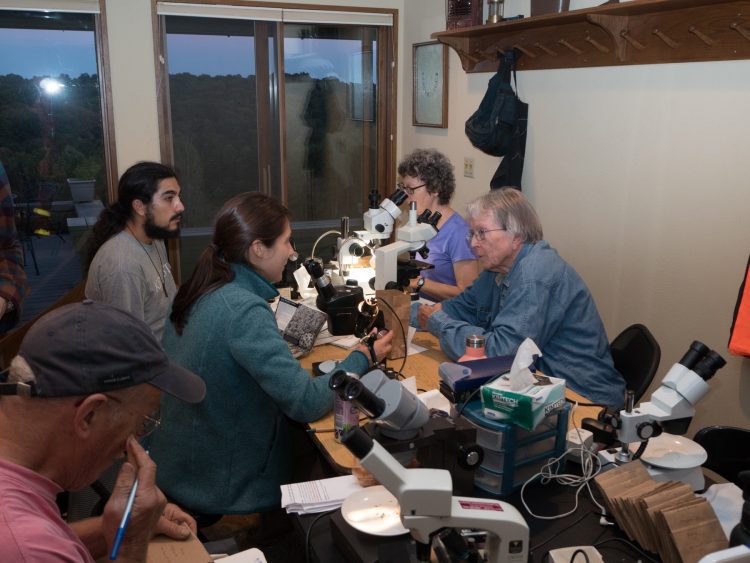
OMLA members learn from each other.
LICHEN RESULTS. Three locations in the Crane Hollow Preserve were searched for lichens: Early Hollow (including the parking area), Goldmine Hollow and Young Hollow. In all areas, only the south-facing slopes were visited. A total of 49 species of macrolichens and 47 crustose species (collected only from Early and Goldmine Hollows) were recorded. There were also 3 species of nonlichenized allied fungi identified.
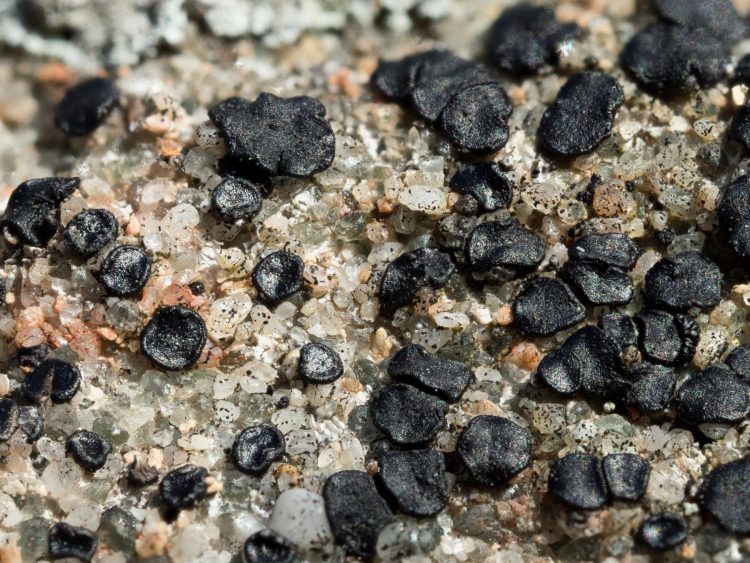
Porpidia subsimplex is a crustose disk lichen.
Hocking is one of the most studied counties in Ohio for macrolichens, with 120 species recorded. Even so, this foray found 4 species which had not been previously reported. Punctelia borreri is listed as new because earlier collections were almost certainly misidentified. Canoparmelia caroliniana is a state-listed species with records from only 5 counties.
There were 8 macrolichens that are reported for the first time in Crane Hollow. Since crustose lichens have not been studied at Crane Hollow all of the crustose species found during this foray are new for Crane Hollow.
Crustose lichens have not been well studied in Ohio and many of these listed below are probably new for Hocking County. Several crustose specimens were collected which did not fit the existing keys and may either be atypical or new to science. These were sent to Dr. James Lendemer at the New York Botanic Garden for his expert opinion.
References cited
Andreas, B.K. and D. H. Lucas. 2017. Additions to the Ohio moss atlas: contributions to the Ohio moss atlas by a group of amateur and professional bryologists. Evansia 34: 156 – 166.
Showman, R.E. 1987. Macrolichen flora of Crane Hollow, Hocking County, Ohio. Ohio J Sci: 27 – 29 Showman, R. E. 1993. Macrolichen flora of Crane Hollow – Additional Studies. Unpublished report. 3 p.
Snider, J.A. and S. He. 1990. A Catalogue of the Bryophytes of Crane Hollow Nature Preserve, Hocking County, OH. Unpublished Report.106p.
Bryophytes of the 2018 Fall Foray in Crane Hollow Preserve, Hocking County
* = New county record + = New for Crane Hollow Preserve
Locations: S = Schoolhouse, E = Early Hollow, G = Goldmine Hollow, Y = Young Hollow.
Mosses
Amblystegium varium Y
Amphidium mougeotii E
Anomodon attenuatus S, E, Y
A. rostratus S, E
Aphanorrhegma serratum G
Atrichum angustatum E, G, Y
A. crispulum S, E, G
Aulacomnium heterostichum S, G
Barbula unguiculata S
Brachythecium falcatum+ S
B. laetum+ S, G
B. plumosum G
Brothera leana S
Bryhnia graminicolor E, G
B. novae-angliae S, E
Bryoandersonia illecebra S, E
Bryoerythophyllum recurvirostrum* E
Bryoxiphium norvegicum E
Bryum argenteum S
B. lisae var. cuspidatum+ S
B. pseudotriquetrum S
Calliergonella lindbergii G
Campylium chrysophyllum S
C. hispidulum Y
Campylopus tallulensis E, Y
Ceratodon purpureus E
Climacium americanum S
C. kindbergii E
Ctenidium molluscum E, Y
Dicranella heteromalla G, Y
Dicranodontium denudatum E
Dicranum condensatum+ Y
D. flagellare S, E, G, Y
D. fuscescens+ E
D. fulvum S, E, G, Y
D. montanum S, E, G, Y
D. ontariense E
D. scoparium S, E, Y
D. spurium S, Y
Didymodon ferrugineus* S
Diphyscium foliosum S, E, G
Entodon seductrix G, Y
Eurhynchium hians G
Fissidens adianthoides E
F. bryoides S, G
F. bushii S, E, G
F. dubius Y
F. elegans E, G
F. osmundioides E, G, Y
F. subbasilaris E, Y
Funaria hygrometrica E
Grimmia laevegata+ Y
Haplohymenium triste E, G, Y
Hedwigia ciliata S
Herzogiella striatella E
Homalotheciella subcapillata E, G
Homomallium adnatum+ E, G
Hookeria acutifolia S, E
Hygroamblystegium tenax G
Hypnum curvifolium S, G
H. imponens S, G, Y
H. pallescens E, G, Y
Isopterygiopsis muelleriana G
Isopterygium tenerum+ S, G
Leskea gracilescens E, G
Leucobryum albidum S, E, G
L. glaucum S, E, G, Y
Mnium hornum S, G
Orthotrichum speciosum* G
Plagiomnium ciliare E, G
P. cuspidatum S, Y
Plagiothecium cavifolium E, G
P. laetum G
Platygyrium repens S, E, G, Y
Platyhypnidium riparioides E, G
Pogonatum pensilvanicum G
Pohlia nutans E, Y
Polytrichastrum ohioense S, E, G, Y
Polytrichum piliferum E, G, Y
Pseudotaxiphyllum distichaceum G
P. elegans E, G
Pylaisiadelpha recurvans E, Y
P. tenuirostris S, E, G, Y
Rhizomnium punctatum E, G
Rhynchostegium serrulatum S, E, G, Y
Schistidium apocarpum+ Y
Sematophyllum adnatum+ S, G
S. demissum S, G
Syrrhopodon texanus E
Taxiphyllum deplanatum S, E, G
Tetraphis pellucida S, E, Y
Thamnobryum alleghaniense E
Thuidium delicatulum S, E, Y
Trichostomum tenuirostre+ G
Tortella humilis Y
Ulota crispula G
Liverworts
Asterella tenella E
Bazzania trilobata S, G
Calypogeia muelleriana G, Y
C. neesiana+ E
C. neogaea G, Y
Cephalozia bicuspidata+ G
C. connivens E
C. lunulifolia S, Y
Cephaloziella rubella+ Y
Cololejeunea biddlecomiae E, G
Conocephalum salebrosum S, E, G
Diplophyllum apiculatum S, E, G, Y
Frullania asagrayana S
F. eboracensis E, Y
Harpanthus scutatus+ G
Jamesoniella autumnalis+ Y
Jubula pennsylvanica E, G
Jungermannia crenuliformis Y
J. pumila S
Kurzia sylvatica E, G
Lophocolea heterophylla S, E, G
Lophozia bicrenata = Isopaches bicrenatus+ Y
Metzgeria crassipilis+ G
Nowellia curvifolia S, E, G
Odontoschisma denudatum S, E, Y
O. prostratum E, G, Y
Pallavicinia lyellii E, G, Y
Pellia epiphylla E, G
Plagiochila austinii+ G
P. porelloides E, G
Porella platyphylla S, G
Radula complanata+ G
Scapania nemorea S, E, G, Y
Hornworts
Notothyas orbiculatus E
Lichens of the 2018 Fall Foray in Crane Hollow Preserve, Hocking County
* = New county record + = New for Crane Hollow Preserve
Locations: E = Early Hollow, G = Goldmine Hollow, Y = Young Hollow.
Foliose and Fruticose Lichens
Anaptychia palmulata E
Candelaria concolor E
Canoparmelia caroliniana* + G
Cladonia coniocraea E, G, Y
C. cristatella E, Y
C. cylindrica E
C. didyma* + G, Y
C. furcata E
C. macilenta+ Y
C. mateocyatha+ E
C. ochrochlora* + E
C. pyxidata E
C. pyxidata complex E, G, Y
C. rangiferina = Cladina rangiferina E, G, Y
C. squamosa E, G, Y
C. subtenuis = Cladina subtenuis E, G, Y
C. uncialis E, Y
Crespoa crozalsiana = Canoparmelia crozalsiana E, G, Y
Dermatocarpon luridum E
Dibaeis absoluta Y
Flavoparmelia baltimorensis Y
F. caperata E, G, Y
Heterodermia obscurata E, G, Y
H. speciosa Y
Hypotrachyna livida G, Y
H. minarum = Parmelinopsis minarum E, G, Y
H. showmanii E, G
Imshaugia aleurites E, G, Y
I. placorodia E
Lasallia papulosa E, G, Y
Melanelixia subaurifera E
Myelochroa aurulenta E, G
M. galbina G
Parmelia sulcata E
Parmotrema hypotropum E, G, Y
P. reticulatum = Rimelia reticulata+ E
Phaeophyscia adiastola Y
P. rubropulchra Y
Physcia adscendens E
P. americana E, G, Y
P. millegrana E, G, Y
P. stellaris E, G
Punctelia borreri* + E
P. caseana = Punctelia subrudecta E, Y
P. missouriensis+ E, G
P. rudecta E, G, Y
Pycnothelia papillaria E
Pyxine sorediata E, G
Usnea amblyoclada Y
U. strigosa E
Xanthoparmelia conspersa E, Y
Crustose Lichens
Acarospra fuscata E
Arthonia apatetica G
Bacidia schweinitzii E, G
B. sorediata E
Biatora printzenii E, G
Botryolepraria lesdainii E, G
Caloplaca reptans E
Candelariella efflorescens E
Catillaria nigroclavata E
Chaenotheca xyloxena E
Chrysothrix caesia E
Flakea papillata G
Fuscidea recensa E
Graphis scripta E, G
Hypocenomyce scalaris E
Japewwiella dollypartoniana E
Julella fallaciosa E
Lecania croatica E
Lecanora hybocarpa E, G
L. layana E, G
L. nothocaesiella E
L. oreinoides E
L. strobilina E
Lepra pustulata G
Lepraria caesiella G
L. cryophila E, G
L. disjuncta E
L. finkii E, G
L. harrisiana E, G
L. hodkinsoniana E, G
L. neglecta E, G
L. normandinoides E, G
Leprocaulon adhaerens E
Ochrolechia yasudae E
Pertusaria globularis E
P. plittiana E
Phlyctis petraea E
Porpidia albocaerulescens E, G
P. crustulata G
P. subsimplex E
Racodium rupestre G
Rinodina papillata E
Scoliciosporum pensylvanicum G
S. umbrinum G
Segestria lectissima E
Thelotrema subtile G
Trapelia placodioides E, G
Viridothelium virens E
Nonlichenized “allied fungi”
Chaenothecopsis debilis E
C. nigra E
Mycoporum compositum E, G
